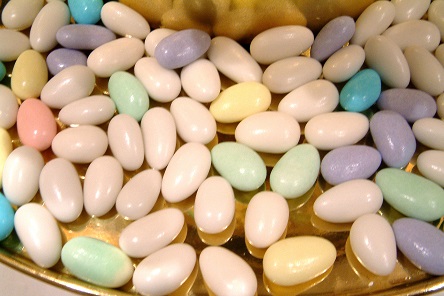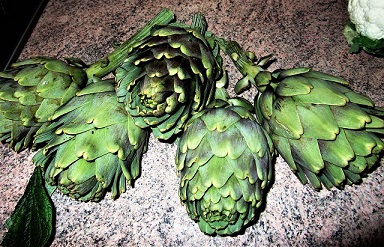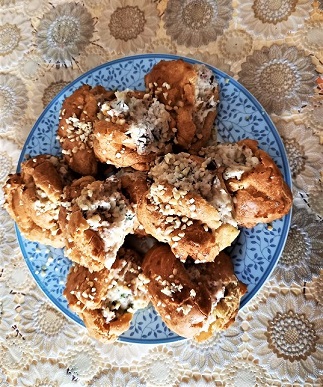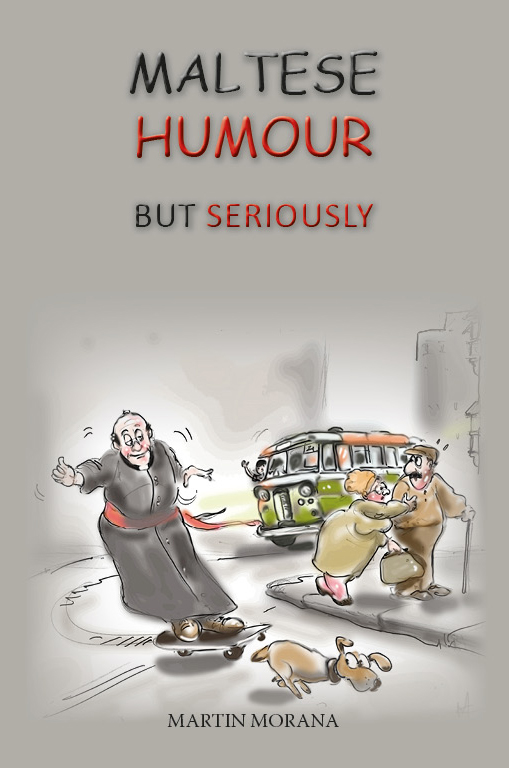Maltese Food
connected to
the Catholic Calendar
IntroductionIt is essential for all humans to nourish themselves daily in order to maintain their healthy state of being. However, some of the world’s religions impose rules onto their faithful that dictate days of fasting during which one would abstain from certain essential foods. In former times, in the Roman Catholic faith, there were multiple rules that forbade certain foods and drinks from being consumed on particular days throughout the liturgical year. Why fasting? Mainly because this was a way to purify the soul, in emulation of Christ’s forty days of spiritual retreat in the desert. (Matt 4:1-2; Luke 4:1-3). Without food the soul would be better equipped to attain a state of piousness.
Fasting and Abstention
Denouncing the normal intake of foods was to be achieved in two ways: by fasting on certain days and abstaining from the quality of food that is normally consumed, that is partly or completely eliminating certain types of food from the daily regime. In olden times, fasting and abstention were to be observed regularly at least three times a week, that is on a Wednesday, a Friday and a Saturday, throughout the whole year. In the main, abstention and fasting focused on the elimination of meats, eggs, milk and other dairy products. In more recent times, sweets and alcohol were also included.

There was a time when the rules of fasting and abstinence were very strict indeed. Until the second half of the twentieth century, all those over the age of seven were obliged under penalty of sin not to eat any meat, while those over the age of twenty-one were to adhere to a strict and exemplary manner of fasting. As from the age of sixty and over were exempt from fasting. Then, after the Second Vatican Council (1964), rules began to be gradually mitigated, although many, especially the old folk, still adhered of their own free will, to the previously established regulations.
Vġili
Apart from fasting three times a week, there were other days throughout the year when fasting was to be observed, as for instance, on the eve of certain important feasts. Such fasting vigils became known as vġili, (from the Italian, vigilia). These were carried out on the eve of Pentecost, All Saints Day, Santa Maria and Christmas.
Kwattrutempi
Apart from these, there were even other days of fasting, known as the Kwattrutempi, held on four other occasions – quattro means four – throughout the year. Each of these fasting periods lasted three days. These were specifically attached to the Advent Sundays (Maltese: Ħadd tal-Avvent), prior to Christmas; Sundays in Lent (Ħadd ir-Randan); Pentecost and Santu Kruċ, a feast that was celebrated on September 13.
Type of fasting

In their strictest sense, the rules of fasting required that one consumes only one meal a day, usually at noon. As for the evening meal, a light snack was the appropriate meal to have. There were those who took fasting to a more stricter level. A snack would mean having a couple of slices of bread that would contain no condiments. In Gozo, for instance, in the evenings, they used to eat a meal made of dough and semolina, seasoned with oil.
In earlier times, breaking the rules of fasting was considered a sinful act. At the time when the papal inquisition officiated in Malta, (1561 – 1798), such breaking of the rules was to be reported to the inquisitor for the offender to be judged by the Tribunal. The guilty person was usually handed down a light sentence, more in the way of a penance. A first time offender was often bound to recite prayers and attend mass. For the second time offender, the accused was given a harsher sentence, that could well result in imprisonment inside one of the dark dungeons of the same Inquisitor’s Palace.
Lent

Lent is the period in the liturgical calendar when the faithful were meant to reach a high level of spiritual purification by fasting, thus empowering them to partake in the Good Friday and Easter liturgical rites. Lent started on Ash Wednesday, (Maltese: Ras ir-Randan – as in Arabic, Ramadan) until Maundy Thursday (M. Ħamis ix-Xirka), the eve prior to Good Friday. However, the days leading to Ash Wednesday, that is, carnival days, were conveniently established for one and all to consume meat, dairy products and fatty foods. Such days were established in order to ensure that no such foods would be left

stored in the larder, once the 40 days of fasting commenced. Hence the words Carnevale (carne vale: meat is permissible) and Martedi / Mardi Gras – referring to the consumption of fatty foods on Shrove Tuesday). From merely indulging oneself gastronomically in rich foods during carnival days, a flair for making merry by dressing up in character costumes (Maltese: maskerati)

crept in, in Italy and later into Malta. Thus, the religious aspect of carnival soon changed into a full blown secular period of merriment. Could this buffoonery have been instigated by the excess drinking of wine? No wonder that carnival Sunday had a particular term in Maltese, Ħadd il-Blugħ – the Sunday of craziness.
Funerary foods

Throughout the normal lives of the faithful, another occasion for fasting was also observed. This was related to the mourning of a deceased person. In previous centuries, it was customary for those closest to the defunct to abstain from eating any cooked food following his demise. Pots and pans were placed face down in the kitchen symbolically, as no cooked food was to be consumed throughout the following days. In compensation, it was customary for the relatives, who did not live in the same house, or else neighbours, to provide food, which they would have prepared themselves, to the mourners in the household. This custom was called the għaswa in Maltese (from the Arabic għaża, meaning, condolence or consolation.
Food permissible during fasting
 To make up for the lack of nutrients during fasting, one needed of course to turn to other alternative food stuffs. Bread, the staple food of the Maltese, was the most widely eaten because it was cheap, more available and filling. This staple food was eaten with condiments such as olives, anchovy, sardines, herring and other dried and salted fish, such as cod (M. bakkaljaw). They would of course turn also to vegetable dishes, according to season. The diet ranged from boiled artichokes, either eaten on their own, or else stuffed with anchovy. Fish soups were also a favourite. Other vegetables were cauliflower, peas,
To make up for the lack of nutrients during fasting, one needed of course to turn to other alternative food stuffs. Bread, the staple food of the Maltese, was the most widely eaten because it was cheap, more available and filling. This staple food was eaten with condiments such as olives, anchovy, sardines, herring and other dried and salted fish, such as cod (M. bakkaljaw). They would of course turn also to vegetable dishes, according to season. The diet ranged from boiled artichokes, either eaten on their own, or else stuffed with anchovy. Fish soups were also a favourite. Other vegetables were cauliflower, peas,

endives, spinach and as from the late 19th century, potatoes. One must not forget mentioning broad beans, cooked together with tiny pasta beads, to make a thick couscous like concoction (Maltese: kusksu). Other foods were snails with garlic, (M. allioli). Then there were always a variety of pasta dishes that one combined with such ingredients as salted tuna.
As light snacks, during Lent, there were and still are, the sfineġ (plural of sfinġa) – fritters stuffed with anchovy. Kwareżimal is a sweet confectionery, made of ground almonds and mixed with flour, added with a few flakes of cinnamon, black honey and a few drops of rose water (M. ilma żahar). After baking in the oven, the kwareżimal is soaked with an amount of honey, and pistachios are spread on top. Another typical Lent savoury are the karamelli tal-ħarub (a syrup extracted by boiling charob (locust beans) pods, and cooled and chipped into tasty bits of sweets).
Christmas and Easter foods

Christmas and Easter also have their own kind of food. Yet these are not obligatory, but merely traditional. On Christmas Day one is accustomed to cook special roast meat dishes for lunch. Qagħaq tal-għasel are pastry rings stuffed with treacle, associated with Christmas, as is the imbuljuta (chestnut soup). Of course English type of traditional dishes and sweets, such as turkey and Christmas log are now quite popular.

On Easter Sunday, roast meat is eaten for lunch; it is not uncommon to serve roast lamb as a favourite traditional dish. The universal chocolate eggs are often presented as gifts to children, either on their own, or else served on pastry. Such pastry is often given a human or animal shape. This pastry is known in Maltese as figolla; originally it was formed solely in the shape of a lamb, thus symbolising the sacrificial lamb, slaughtered to commemorate both the Jewish Passover as well as the death of Christ. The figolla (from the Maltese, figura) is nowadays still given as an Easter present to children. During the Easter Sunday procession, as the statue of the Risen Christ is carried in procession through the streets of the town, children are supposed to raise their figolla in front of the statue to have it blessed by Christ.
All Souls Day and Saint Martin of Tours

Not to be ignored is another day in the calendar year; that is All Souls Day, on November 2. This is commemorated by the production and consumption of particular pastry, namely the l-għadam tal-mejtin i.e., ‘bones of the dead’. A couple of weeks later there is the commemoration of St Martin of Tours on which day, bags of nuts, such as chestnuts, almonds, hazelnuts, as well as other fruit, such as pomegranate are presented to children in a small hand held bag made of cloth.

The żeppoli of the Feast of St Joseph
 In Italian culture a zeppola (plural: zeppole) also called frittelle in northern Italy, is an pastry consisting of a deep-fried dough ball of varying size but typically about 4 inches (10 cm) in diameter. This doughnut or fritter is usually topped with powdered sugar, and may be filled with custard, jelly, cannoli-style pastry cream or buter and honey mixture. The consistency ranges from light and puffy, to bread- or pasta-like. It is eaten to celebrate Saint Joseph Day on March 19, which is a Catholic feast day. Zeppole are typical of Rome and Naples, Sicily, Sardinia and Malta. They are also known as sfinge.
In Italian culture a zeppola (plural: zeppole) also called frittelle in northern Italy, is an pastry consisting of a deep-fried dough ball of varying size but typically about 4 inches (10 cm) in diameter. This doughnut or fritter is usually topped with powdered sugar, and may be filled with custard, jelly, cannoli-style pastry cream or buter and honey mixture. The consistency ranges from light and puffy, to bread- or pasta-like. It is eaten to celebrate Saint Joseph Day on March 19, which is a Catholic feast day. Zeppole are typical of Rome and Naples, Sicily, Sardinia and Malta. They are also known as sfinge.
 This book deals with the story of Maltese humour since Roman times up to present.
This book deals with the story of Maltese humour since Roman times up to present.
The author tackles humour both on the individual level as well as that which was and is presented in the theatre and on screen. The writer draws from many past and present anecdotal episodes and situations to elucidate on the genral state of the Maltese psyche. Humour is a two way style of communication that sizes up the temperament of both the presenter as well as the receiver of humour.
Paperback; paġni: 226. Euro 12.95. Available at bookstores …. If you are in Valletta try Agenda or Meli Bookshops.
Also available in ebook format from Amazon Kindle. Price: $.7.30.


The Jewish Tradition was to fast on Tuesdays and Thursdays so the Christians adopted Wednesdays and Fridays. The Christian Calendar is universal and is contained in English in the Book of Common Prayer 1662 page lvi. In the English usage the word “Catholic” means Roman Catholic, so universal is better.
LikeLike